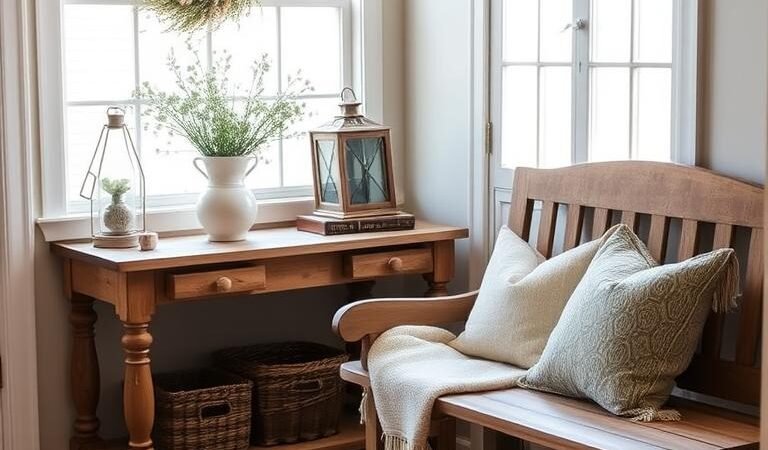The space just inside your home sets the tone for what lies beyond. A well-designed area blends comfort with functionality, making it inviting for both residents and visitors. Rustic touches, like weathered wood or vintage textiles, add character while keeping things cozy.
Designer Alexis Garrett transformed her beach cottage with a Dutch door, allowing natural light to brighten the space. This clever adaptation shows how small changes can make a big impact. Thoughtful details—such as cheerful paint colors or woven baskets—enhance the overall aesthetic.
Whether you prefer subtle accents or bold statements, the right ideas can turn this transitional zone into a standout feature. Below, explore practical ways to elevate your design while maintaining warmth and charm.
Key Takeaways
- The first impression of a home starts at the entrance.
- Rustic elements add warmth and personality.
- Natural light enhances the space effectively.
- Small design changes create significant impact.
- Functional storage keeps the area clutter-free.
1. Start with a Sunny Dutch Door
Natural light floods in when you opt for a split-door design. Dutch doors—divided horizontally—allow airflow and sunlight while maintaining privacy. Unlike solid front doors, they create a seamless indoor-outdoor connection.
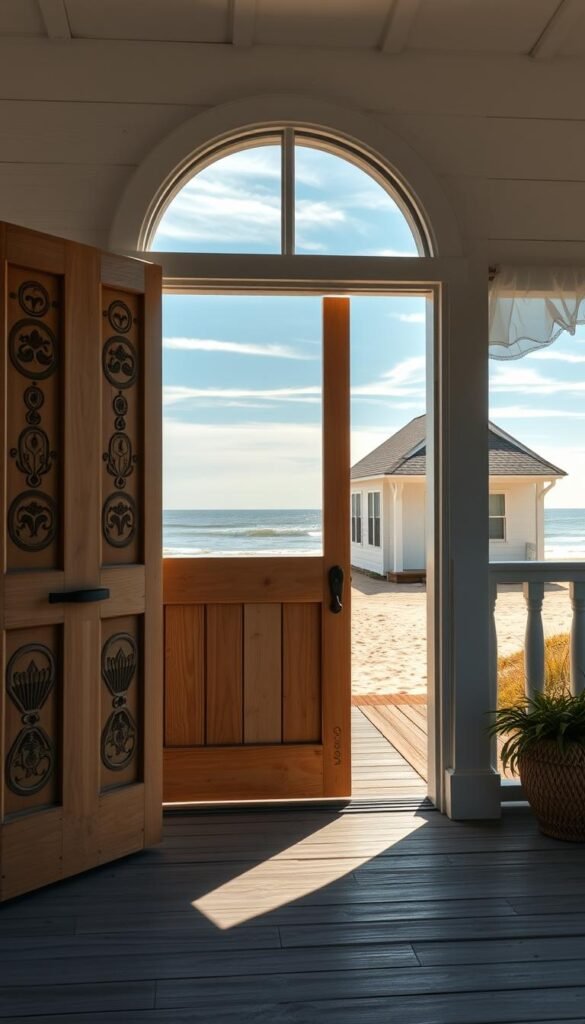
Lower Split Design for More Light
Designer Roger Davis transformed his California cottage with a 60/40 split door. The lower section features vertical planking, mirroring the vaulted ceilings. This clever touch enhances coastal cohesion while maximizing light.
Get the Look: Kensington Blue by Benjamin Moore
For a serene color, Benjamin Moore’s Kensington Blue delivers. Its soft gray-blue undertones complement coastal and transitional styles. Pair it with wall hooks for beach towels or seasonal accessories—a perfect entryway idea.
Pro tip: Choose high-quality exterior paint to withstand sun exposure. Semi-gloss finishes resist peeling, keeping your house welcoming year-round.
2. Bold Wallpaper for a Lively Touch
Bold patterns bring energy and personality to any space. An accent wall with large-scale paisley or floral prints becomes an instant conversation starter. These designs also cleverly disguise scuffs in high-traffic areas.
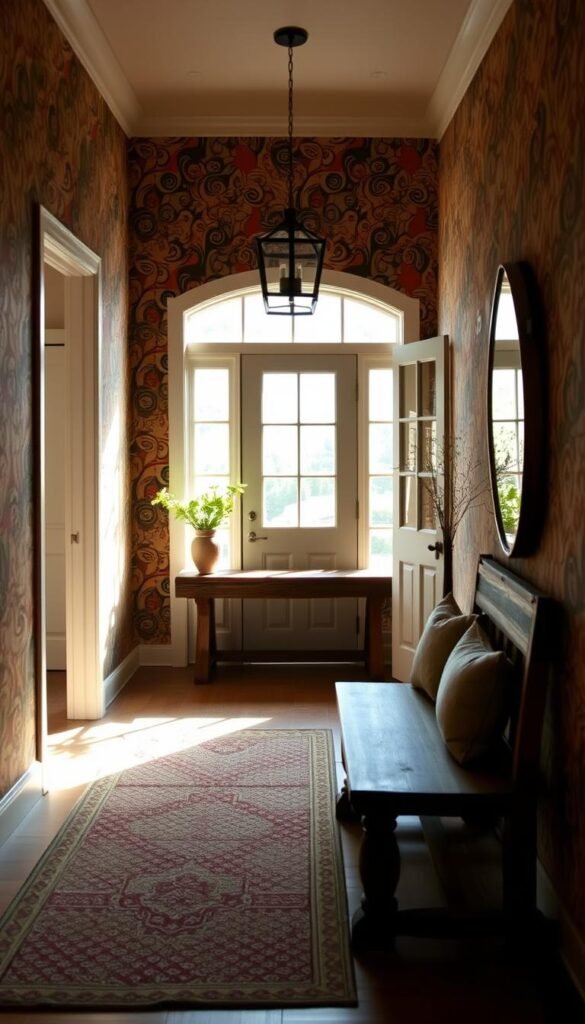
Large-Scale Paisley or Floral Prints
Designer Matthew Kisiday transformed a West Virginia foyer with Jasper’s Kashmir collection. The Mughal-inspired motifs honor the homeowner’s heritage while adding depth. Neutral Shaker-style furniture balances the vibrant walls.
Try “Kashmir” by Jasper for Authentic Charm
This wallpaper blends heritage style with rich paisley swirls. Pair it with Greek key floor stencils for cohesion. Pro tip: Use lining paper to smooth uneven plaster walls before application.
- Timeless decor ideas: Coordinate patterns with tile borders or vintage rugs.
- Functional beauty: Bold prints distract from daily wear-and-tear.
- Quick refresh: Swap accessories seasonally to highlight the wall’s versatility.
3. Paint Your Front Door a Cheerful Hue
A vibrant front door instantly boosts curb appeal. It’s the first splash of color guests see—a chance to reflect your house’s personality. Designer Max Humphrey’s neon yellow entryway, paired with a Thayer Design Studio rug, proves bold choices create lasting impressions.
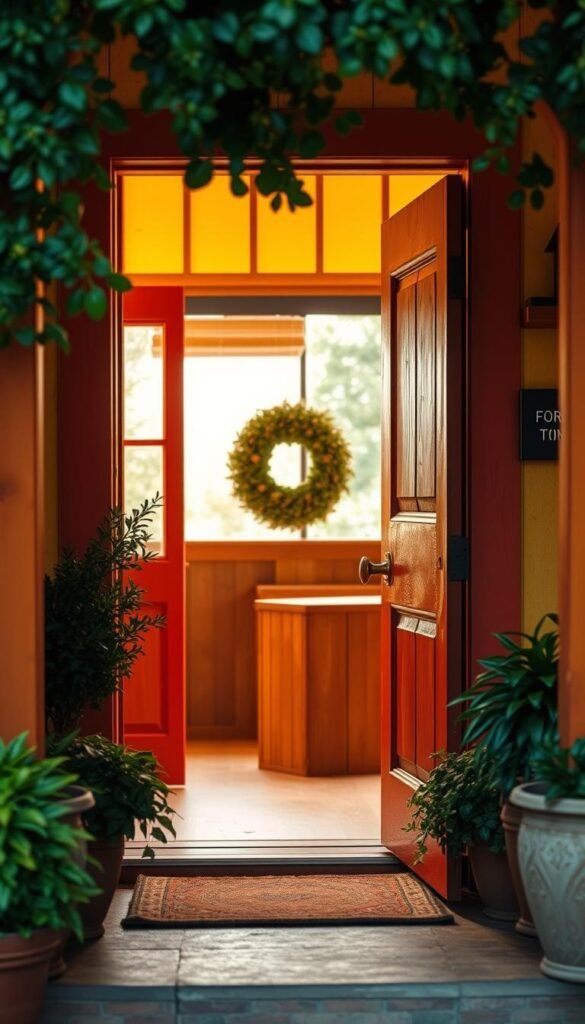
Neon Yellow or Robin’s-Egg Blue
High-energy hues like Benjamin Moore’s Chartreuse radiate joy. For a calmer vibe, try Quiet Moments—a soft blue-green. Humphrey balanced his rancher’s neon door with rustic tramp art mirrors, blending modern design with vintage charm.
Durable Paint Options Like Benjamin Moore’s Chartreuse
South-facing doors need UV-resistant paint to prevent fading. Semi-gloss finishes withstand weather while adding subtle shine. Pro tip: Coordinate doormats or mailbox accents for a polished look.
| Paint Finish | Best For | Durability |
|---|---|---|
| Semi-Gloss | High-traffic doors | Resists peeling, 5+ years |
| Satin | Subtle sheen | Moderate wear, 3–4 years |
| Matte | Vintage appeal | Requires touch-ups |
- Crisp contrast: Pair bold doors with Farrow & Ball’s All White trim.
- Cohesion trick: Echo the door color in outdoor planters or shutters.
- Test first: Paint a swatch to see how light changes the tone.
4. Install a Rustic Peg Rack
Rustic hooks offer both charm and function in tight entryways. They turn blank walls into practical storage spots for coats, hats, and bags. Designer Read McKendree’s Cape Cod cottage showcases this perfectly—a reclaimed oak rack paired with a vintage ship painting.
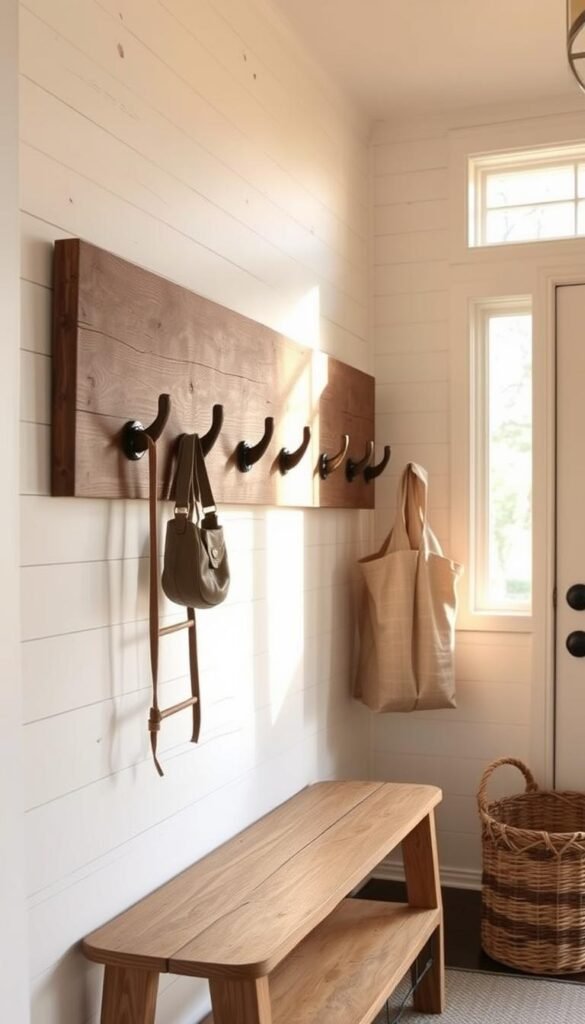
Space Hooks 6 Inches Apart for Maximum Use
Maribeth Jones’ vertical formula ensures efficiency: space hooks 6 inches apart. This prevents overcrowding while fitting more items. Wrought iron hooks suit industrial mudroom styles, while knotted wood adds organic texture.
Add Nautical or Botanical Art Above
Elevate the wall with thematic art. Lakeside homes shine with vintage oars; woodland cabins pop with pressed fern displays. For coastal entryway ideas, pair hooks with rope-wrapped mirrors.
| Material | Best For | Weight Capacity |
|---|---|---|
| Reclaimed Wood | Farmhouse styles | 15 lbs per hook |
| Wrought Iron | Industrial spaces | 25 lbs per hook |
| Brass | Modern aesthetics | 20 lbs per hook |
- Protect floors: Add felt pads to stool legs if using a bench below.
- Secure installation: Use drywall anchors for plaster walls to hold heavy shoes or bags.
- Layer textures: Mix woven baskets overhead for extra storage.
5. Create a Chalkboard Message Center
A chalkboard transforms blank walls into interactive hubs for families. It’s equal parts functional and stylish—ideal for meal plans, reminders, or welcome notes. Designer David Hillegas showcases how decorative frames elevate these boards beyond classroom utility.
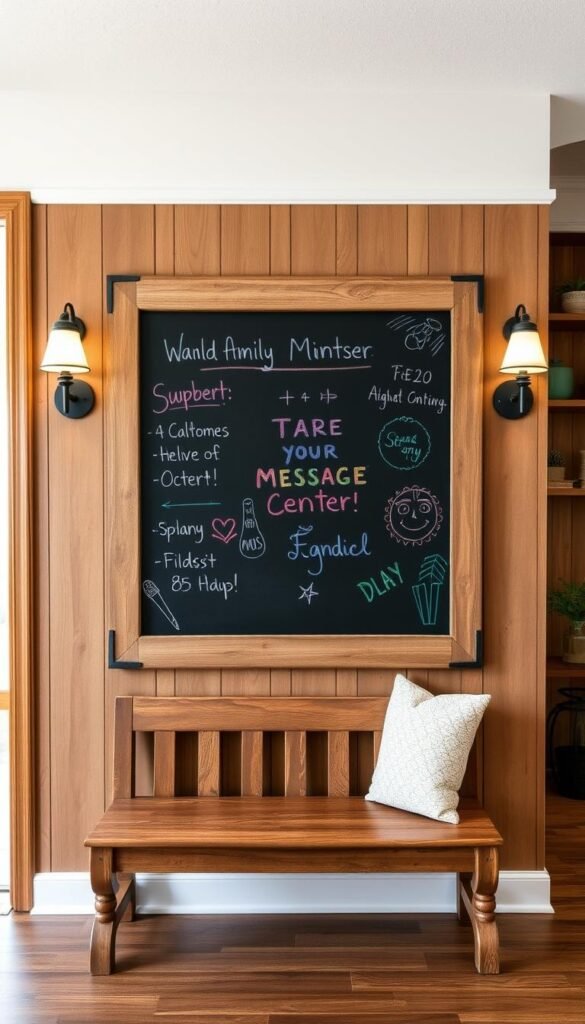
Family Menus and Welcome Notes
Matte finishes absorb chalk better, reducing glare. Glossy surfaces erase cleanly but suit low-traffic spots. For daily use, combine both: chalk markers for permanent headings (like “This Week’s Menu”) and regular chalk for updates.
- Weekly templates: Sketch grids for meal plans or school events.
- Magnetic hybrids: Display keys or mail beneath handwritten notes.
- Seasonal flair: Swap holiday doodles or gratitude lists monthly.
Vintage-Frame Chalkboards for Texture
Distressed barn wood frames complement rustic decor, while gilded Rococo accents suit glam spaces. Hillegas’ Moroccan-inspired design pairs scalloped edges with brass hooks—doubling as a entry drop zone.
| Frame Style | Best For | Maintenance Tip |
|---|---|---|
| Barn Wood | Farmhouse aesthetics | Seal with matte varnish |
| Rococo Gold | Eclectic spaces | Dust with microfiber cloth |
| Industrial Metal | Modern lofts | Prevent rust with wax coating |
Pro tip: Place near lighting to highlight handwritten notes. A sconce or pendant ensures readability after dark.
6. Layer Patterned Rugs for Depth
Layering rugs adds instant dimension to any transitional space. Designer Cameron Ruppert demonstrates this with a graphic kilim over a neutral jute base—a trick that pulls color palettes together while softening footsteps. The contrast between crunchy jute and silky kilim threads creates organic texture underfoot.
Geometric or Clover Motifs
Josef Frank’s Klöverblad pattern exemplifies Scandinavian-farmhouse synergy. Its clover motifs, paired with winding botanical prints, add whimsy without overwhelming small spaces. For cohesion, match rug hues to existing furniture or wall art—like Ruppert’s purple Roman shade echoing the kilim’s plum accents.
Non-Slip Pads for Safety
Secure layered rugs with dual-grip solutions. Rubber mesh pads suit high-traffic areas, while silicone dots prevent slippage on hardwood. Pro tip: Trim pads to fit each rug layer individually for seamless stacking.
- Cleaning natural fibers: Blot mud with vinegar-water mixes; avoid harsh scrubbing on jute.
- Rotate seasonally: Swap heavy wool rugs in winter for lightweight cotton in summer to reduce wear.
- Anchor large rugs: Ensure the base layer extends 12+ inches beyond furniture legs for stability.
For more design inspiration, explore these entryway ideas that balance form and function. A well-layered floor not only elevates your home’s aesthetic but also withstands daily chaos with grace.
7. Neutral Wallpaper with Subtle Texture
Subtle textures on walls create depth without overwhelming small spaces. A Maryland foyer transformed with Nicholas Herbert’s “Toile Des Lapins” proves mushroom-toned papers work as transitional neutrals. These velvety backdrops allow bolder furniture or art to shine while maintaining cohesion.
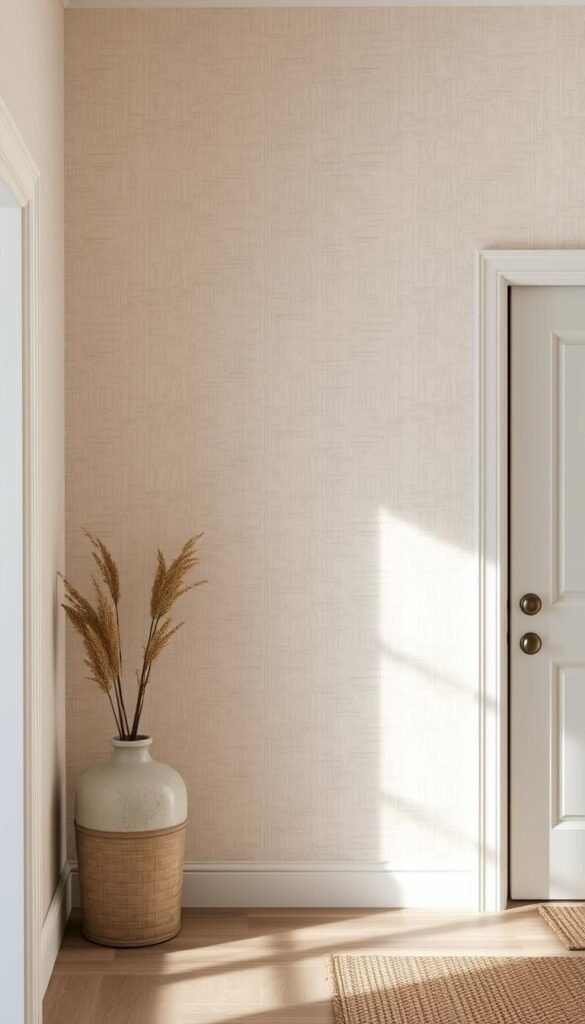
Mushroom Hues and Toile Prints
Toile’s historic pastoral scenes diffuse light differently than whisper-soft grasscloth. Designers often lean toward toile for traditional houses—its crisp lines complement wainscoting. Grasscloth better suits contemporary spaces needing sound absorption.
For gender-neutral appeal, Herbert’s rabbit motif replaces typical floral toile themes. Playful yet refined, this collection pairs perfectly with milk paint finishes on lower wall panels. The matte texture prevents visual competition with glossy trim.
Scale-Matching Guidelines
Proper pattern sizing ensures harmony with your house‘s architectural proportions:
| Space Width | Ideal Pattern Scale | Coordinating Element |
|---|---|---|
| Under 3 feet | Small (under 2″ repeat) | Vertical stripes |
| 3–5 feet | Medium (2–4″ repeat) | Geometric tiles |
| Over 5 feet | Large (4″+ repeat) | Oversized art |
Complete the design with Schumacher’s Prairie collection fabrics:
- Linen drapery: “Wildflower” in Bone for light filtration
- Bench cushions: “Prairie Check” for durable texture
- Table runners: “Botanical Sketch” to echo toile motifs
8. Add a Flip-Top Console Table
A flip-top console table maximizes functionality in tight areas without sacrificing elegance. Designer Dane Tashima proves this with a French-inspired piece paired with a zinc mirror—creating a compact yet polished entry solution. The flip-top design reveals hidden storage, perfect for stashing mail or seasonal items.
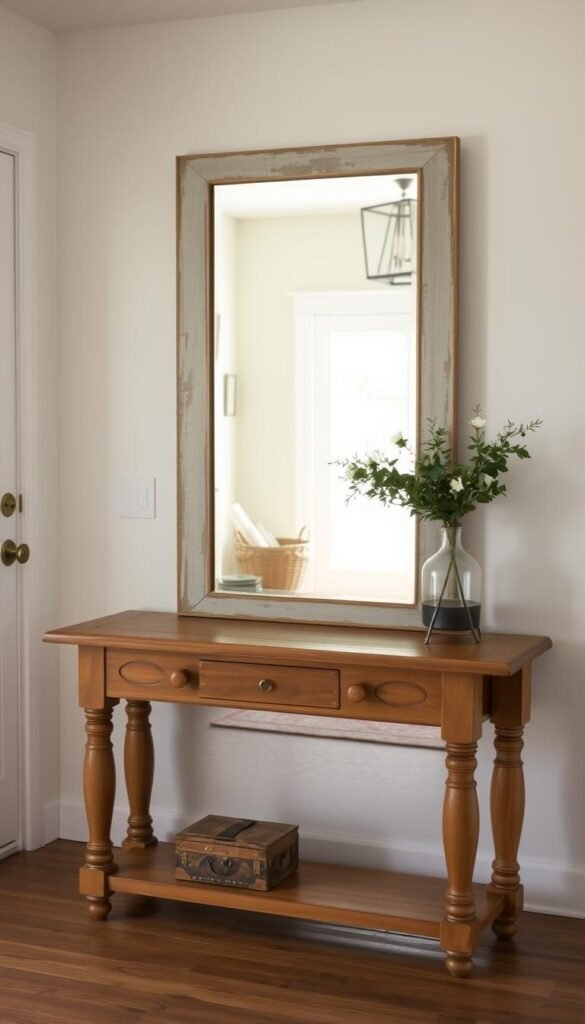
Narrow Designs for Small Spaces
Flip-top tables outperform demi-lune styles for mail sorting. Their vertical storage and drop-leaf mechanism save space while offering surface area when needed. For a cohesive look, match the table’s finish to other decor—like Tashima’s oak table with wrought-iron hooks.
Zinc Mirrors to Reflect Light
Zinc develops a velvety patina over time, adding character. Unlike standard mirrors, its silky surface reflects ambient light softly, reducing glare. Hang one above the table to visually expand the area.
| Tabletop Essential | Purpose | Style Tip |
|---|---|---|
| Catchall tray | Corrals keys | Choose hammered brass for warmth |
| LED candle | Adds evening glow | Opt for flicker-free models |
| Petite succulent | Fresh accent | Use a terracotta pot for texture |
- Drawer organization: Felt dividers keep keys and wallets separate.
- Anchoring tip: Use furniture pads under uneven legs to prevent wobbling.
- Patina care: Clean zinc with vinegar-water mix to preserve its aged look.
9. Design a Mini Mudroom Nook
Even the smallest corner can become a functional drop zone with smart design choices. Maribeth Jones’ Sudbury Yellow cabinetry paired with William Morris “Fruit” wallpaper proves that compact storage solutions can dazzle. This blend of utility and artistry turns cluttered spaces into organized retreats.
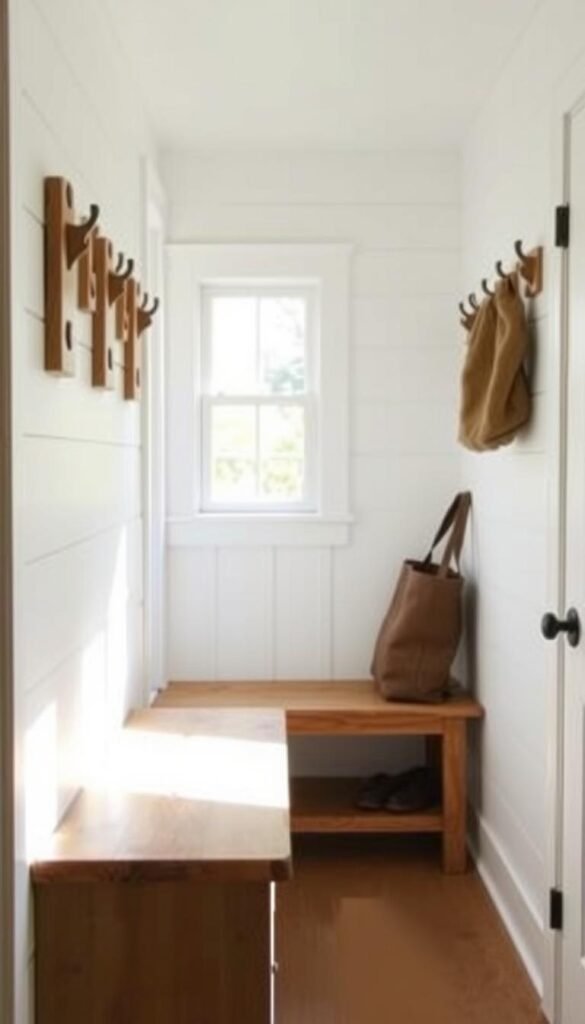
Shaker-Style Pegs and Stools
Shaker pegs offer clean lines and durability—ideal for hanging coats or bags. Pair them with an 18″-deep bench for seating and hidden cubbies overhead. Jones’ design uses reclaimed oak stools, adding rustic texture while maximizing floor space.
Wallpaper Accents Like William Morris “Fruit”
William Morris’ “Fruit” pattern celebrates Arts & Crafts authenticity with intricate botanicals. Its rich hues elevate neutral backdrops without overwhelming tight areas. For pet-friendly homes, opt for wipeable vinyl versions that mimic the original’s depth.
- Compact essentials: Bench + overhead cubbies + 6–8 pegs.
- Fabric picks: Sunbrella Canvas (stain-resistant) vs. Perennials Indoor/Outdoor (fade-proof).
- Boot trays: Galvanized steel (rustic) vs. slatted teak (quick-drying).
Pro tip: Anchor the nook with a vintage runner to protect floors from muddy shoes. Layer textures—like a braided jute mat—for added warmth underfoot.
10. Serene Blue-Green Color Palette
Soft blue-green hues create an instant sense of calm in any transitional space. Designer Christina Salway’s Hudson Valley farmhouse showcases this perfectly—Farrow & Ball’s All White walls paired with Benjamin Moore’s Quiet Moments trim. The combination balances freshness with tranquility, ideal for welcoming guests.
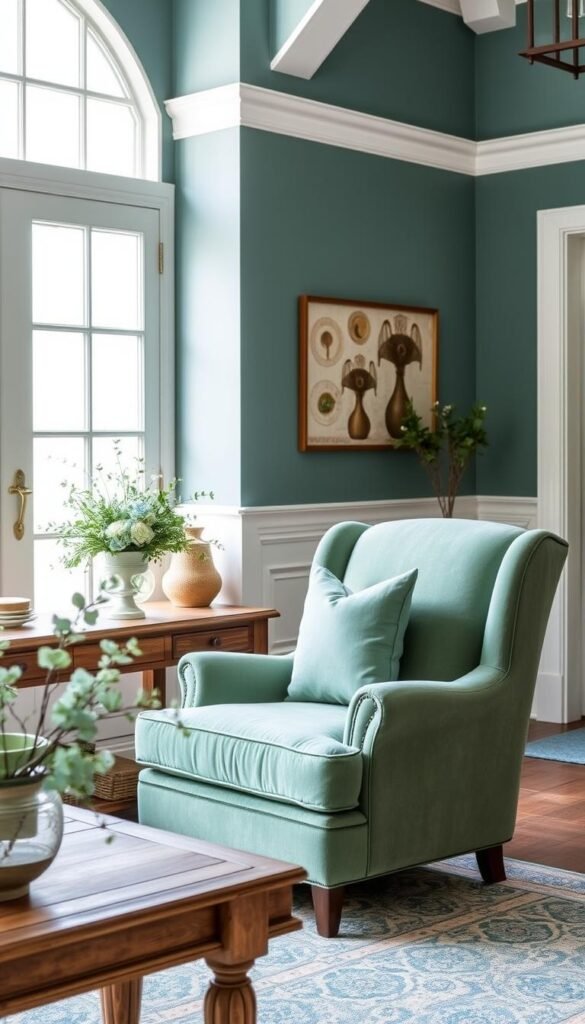
Pair All White Walls with Quiet Moments Trim
Farrow & Ball’s All White has subtle gray undertones, unlike Benjamin Moore’s brighter Chantilly Lace. This makes it harmonize with blue-green’s muted depth. For high-impact design, use mohair rollers to apply gloss trim—its reflective quality amplifies natural light.
Vintage Rugs for Softness
Layer worn Persian rugs to ground the color scheme. Their faded blues and creams add texture without competing with walls. Pro tip: Set eBay alerts for “oversized vintage Tabriz” or scout estate sales for hand-knotted wool.
- Door hardware: Unlacquered brass knobs develop a patina that complements organic styles.
- Psychological pull: Blue-green tones lower heart rates, making arrivals feel instantly at ease.
- Maintenance: Dust high-gloss trim weekly with microfiber to prevent smudges.
11. Preserve Original Wood Details
Original woodwork tells a home’s story—preserving it honors craftsmanship while adding soul. Designer Claire Zinnecker’s Texas farmhouse showcases this perfectly, with sun-dappled oak beams and a cheesecloth-wrapped ceiling. These elements bridge history and modern design, creating a space that feels both timeless and intentional.
Sealed Chipped Paint for Patina
Aged paint chips reveal layers of a house’s past. Instead of stripping them, apply a clear sealant. Matte polyurethane maintains a velvety finish, while satin adds subtle sheen. For pre-1978 homes, test for lead paint first—the National Trust for Historic Preservation offers safety guidelines.
- Durability: Satin resists fingerprints; matte hides imperfections.
- Complementary accents: Edison bulb fixtures cast warm light on textured walls.
- Rustic hooks: Railroad spikes add industrial edge to Shaker-style pegs.
Screen Doors for Farmhouse Authenticity
Original screen doors aren’t just nostalgic—they’re practical. Their woven mesh promotes airflow, reducing humidity in coastal or Southern houses. Zinnecker’s pivoting Dutch screen door frames the entry with breezy charm, while protecting refinished floor planks from muddy paws.
| Sealant Type | Best For | Dry Time |
|---|---|---|
| Matte Polyurethane | Heavily weathered wood | 24 hours |
| Satin Polyurethane | High-touch surfaces | 18 hours |
Pro tip: Layer cheesecloth over ceiling beams for diffused light. Its loose weave softens shadows without blocking brightness.
12. Vintage Rugs on Freshly Painted Floors
Timeworn rugs tell stories underfoot, blending history with fresh design. Designer David A. Land layered a sun-faded Persian rug over checkered black-and-white floors, proving contrast creates character. This interplay of old and new anchors a home’s aesthetic while adding tactile warmth.
Worn Stair Runners for Character
Antique runners soften footsteps while highlighting architectural details. Look for wool or hemp weaves—their natural fibers resist fraying. For safety, secure edges with double-sided carpet tape or silicone caulk dots.
- Pattern play: Pair diamond stencils with floral rugs for visual tension.
- Pet-friendly paints: ECOS Paints’ no-VOC formula withstands paw traffic.
- Noise control: Jute underlays mute creaky stairs.
Dog Paintings or Portraits for Whimsy
Early 20th-century hunting prints or custom pet art inject personality. Land’s terrier portrait, flanked by Shaker pegs, balances function and charm. For cohesion, frame artworks in matching stained oak or gilded finishes.
| Rug Anchor | Best For | Installation Tip |
|---|---|---|
| Carpet tape | Low-pile rugs | Press edges with a rolling pin |
| Silicone dots | High-traffic areas | Space 6″ apart for grip |
Pro tip: Test floor paint swatches at different times of day—natural light shifts blue-gray tones dramatically.
13. Bamboo Hall Trees for Compact Storage
Bamboo hall trees blend form and function in tight spaces, offering sleek storage with organic texture. Unlike bulkier wood units, their slender frames fit narrow entryway walls while providing hooks, shelves, and mirrors. Designer Ali Harper proves this with a Farrow & Ball London Clay backdrop—a moody gray-green that lets golden bamboo tones shine.
Mirror and Shelf Combos
Integrated mirrors amplify natural light in windowless areas. Harper’s design pairs a oval mirror with open cubbies for baskets or leather-bound books. For stability, use anti-tip brackets on top-heavy units—especially important in homes with playful pets or kids.
Earthy Wall Colors Like London Clay
Farrow & Ball’s London Clay shifts from gray to olive depending on the light. This chameleon quality complements bamboo’s natural warmth. Style adjacent shelves with mercury glass vases or woven seagrass bins for layered texture.
- Material matchup: Bamboo suits coastal design; rattan excels in farmhouse settings.
- Dusting tips: Use a soft-bristle brush for intricate carvings weekly.
- Color pairing: Sage green doors enhance London Clay’s earthy depth.
14. Repurpose Antique Dressers
Old-world charm meets practicality with repurposed dressers. These versatile pieces offer hidden storage while adding character to any home. Designer Linda Bradford proved this by converting a pine dresser into garden tool organization—blending rustic appeal with modern function.
Pine Pieces for Toiletries or Tools
Solid pine dressers withstand heavy use when properly reinforced. Bradford’s conversion included three key upgrades:
- Drawer lining: Adhesive cork sheets protect wood from tool scratches
- Casters: Locking wheels enable easy movement for cleaning
- Surface guard: Marine varnish resists moisture damage
For electrical additions, consult an electrician to install:
- USB outlets in top drawers for device charging
- LED strip lighting under shelves
- Weight-rated casters (minimum 50 lbs per wheel)
Fresh Paint for a Cohesive Look
Annie Sloan Chalk Paint® transforms dated furniture with velvety finishes. Two top choices for entryway dressers:
| Color | Effect | Pair With |
|---|---|---|
| Old White | Brightens dark corners | Brass bin pulls |
| Country Gray | Masks wear marks | Black cup handles |
Pro tip: Sand edges lightly after painting for a timeworn look. Seal with clear wax for durability against daily use.
Hardware updates complete the transformation. Consider:
- Industrial bin pulls for tool storage
- Ceramic knobs for bathroom conversions
- Leather straps as drawer pulls for rustic decor
15. Two-Tone Tile Floors
Historic homes often feature patterned floors that tell visual stories. Allison Lind’s restoration of a 1920s bungalow showcases how original encaustic tiles can anchor a space with heritage charm. These durable surfaces combine artistry with practicality—perfect for high-traffic entryway zones.
Checkerboard or Custom Patterns
Checkerboard layouts trace back to Colonial wealth displays, where black-and-white marble signaled affluence. Victorian-era homes later adopted the pattern as a modest alternative using affordable cement tiles. Modern interpretations like Kara Mercer’s diamond stencil prove geometric design remains timeless.
- Optical magic: Diagonal layouts visually expand narrow halls
- Color psychology: Charcoal grout adds modern edge; bone-colored softens traditional style
- Historical nod: Original 19th-century encaustic tiles contained beeswax for water resistance
Durable Materials Like Encaustic Cement
Today’s encaustic cement mimics historic recipes with upgraded durability. Unlike porcelain, its layered composition hides wear in high-traffic areas. For snowy climates, textured surfaces provide better slip resistance than glossy alternatives.
| Material | Cold Climate Performance | Maintenance |
|---|---|---|
| Encaustic Cement | Excellent (salt-resistant) | Annual sealing required |
| Porcelain | Good (frost-proof) | Grout cleaning every 6 months |
Pro tip: For wheelchair accessibility, maintain a 1:12 slope ratio at thresholds. Northern homeowners should consider radiant heating systems beneath tiles—they prevent cold shock underfoot while reducing winter energy costs.
Complete the design with unlacquered brass transition strips. Their warm patina develops over time, complementing both vintage and contemporary decor schemes beautifully.
16. Conclusion: Crafting Your Inviting Entryway
Your home’s entrance sets the stage for every moment inside. Balance function and design with smart lighting, purposeful storage, and pieces that tell your story.
Don’t shy from mixing eras and style—a Victorian tile floor pairs beautifully with a mid-century bench. Always measure twice before installations to avoid costly adjustments.
Start small: swap seasonal wreaths or refresh baskets quarterly. Treat this space as an evolving canvas, reflecting your journey through curated layers of texture and art.
Pro tip: A well-placed mirror or vintage rug can instantly elevate the area without a full overhaul. Let creativity guide your updates.
